In the following pages are described and illustrated some of the many "bogus" or "fraudulent" coins that have been and still are being sold to collectors both here and abroad, principally the latter, as genuine and rare Chinese coins. With the lack of authentic published data on Chinese issues, unscrupulous native dealers soon realized the possibilities of foisting on the unsuspecting collecting public pseudo "coins" born of their own imaginative minds. These so called "coins" are, in general, well designed and of fair workmanship, and collected as "fakes" or "curiosities" would form a quite interesting collection. Coins, however, they never were, and their sale as such should cease. The information contained in the present article has been gained during the past few years, and it has been set down in the hope that a certain amount of publicity may do something to curtail the continued issue and sale of these faked pieces. It is regretted that a more complete list could not be published, but it was impossible under the present disturbed conditions to obtain the necessary specimens for photographing, even of the few better-known pieces such as the Shantung Tael, Sun Yat Sen "Memento" ten cents, Yuan Shih Kai third year nickel five cents, Kiangsi "Star" Dollar, and the Feng Yu Hsiang Dollar.
The principal sources of supply have been Tientsin and Peking, and since the outbreak of the Sino-Japanese hostilities very little has been offered, dealers naively volunteering the information that owing to the conditions in the North "New cargo no can come." The business, however, is a too lucrative one not to be kept going, and the latest offerings on the market, two reputed "Soviet" dollars ( Numbers 65 and 66) are reliably reported to have been made here in Shanghai.
Unfortunately no record was made of the size or weight of the various pieces illustrated, but it can generally be taken that the illustrations are of the correct size. In a few cases they may be slightly smaller than the originals, but in no case are they larger.
1. TIBETAN DOLLAR. Silver.
Allegedly issued at Lhasa during the reign of Ch'ien Lung (1736-1796) for use in Eastern Tibet.
Also known as the Panchan Lama Dollar from the bust and inscription on the obverse.
2. "TAO KWONG" EMPEROR MEDALLION. Silver.
One of two medallions said to have been struck in 1821 in commemoration of the commencement of the new reign-that of Tao Kuang (1821-1851). The bust on the obverse is said to portray the Emperor. The Empress appears on the other medallion.
3. "TAO KWONG" EMPRESS MEDALLION. Silver.
The companion piece to Number 2 referred to above.
4.FORMOSAN DOLLAR. Silver.
The obverse of this piece is copied from that of a genuine Formosan Dollar issued during the reign of Tao Kuang (1821-1851). The reverse, however, is entirely imaginative, the genuine coin having an incense burner enclosed by four Manchu characters on the reverse.
5. "TUNG CHIH" MEDALLION. Silver.
Medallion purporting from its inscription to have been struck in Fukien as a "tribute" coin to the Emperor Tung Chih, whose portrait presumably appears on the obverse.
6. "TUNG CHIH" MEDALLION. Silver.
Another medallion similar to the preceeding. Special attention is drawn to the obverse of this piece for comparison with that of Number 11, which is supposed to be a posthumous portrait of the Emperor Kuang Hsu. The similarity is, to say the least, startling, and it would seem as if the designers had been a little careless.
7. "KWANG HSU" EMPEROR MARRIAGE MEDALLION. Silver.
One of two medallions dated 1885 supposedly issued in commemoration of the marriage of the Emperor Kuang Hsu. The Emperor is portrayed on this and the Empress on the companion piece Number 8.
Both these coins are of exceptionally fine workmanship, as can be readily seen from the illustrations, and it must be regretted that so much artistry and skill had not been diverted to some better use.
8. "KWANG HSU" EMPRESS MARRIAGE MEDALLION. Silver.
The companion piece referred to in Number 7.
9. "KWANG HSU" FUKIEN MEDALLION. Silver.
Medallion ostensibly issued in Fukien for use as tribute. The bust on the obverse is supposed to be that of the Emperor Kuang Hsu.
10. "TZU HIS" YUNNAN MEDALLION. Silver.
Medallion similar to the above, but this time issued in Yunnan with the bust of the Empress Tzu Hsi on the obverse.
11. "KWANG HSU" MEDALLION. Silver.
Medallion which from the inscription on the reverse was supposedly issued in commemoration of the Emperor Kuang Hsu after his death.
The similarity of the obverse of this piece with that of number six has already been referred to.
12. "TZU HIS" CHEKING MEDALLION. Silver.
This is said to have been issued by the Province of Chekiang in honour of the Empress Tzu Hsi.
It is also sometimes described and sold as a "Chekiang" Tael.
13. "KWANG HSU" KUANGTUNG MEDALLION. Silver.
A dollar sized medallion purporting to have been issued in Kuangtung in honour of the Emperor Kuang Hsu.
14. "KWANG HSU" KUANGTUNG MEDALLION. Silver.
A fifty cents sized replica of Number 13.
15. "KWANG HSU" SZECHUAN DOLLAR. Silver.
Based on the Szechuan Rupee, this piece was evidently made to provide a dollar-sized coin to go with the Rupee, which is approximately the size of a fifty cents piece and for which it is commonly mistaken.
16. "TZU HSI" SZECHUAN DOLLAR. Silver.
Evidently designed as a companion piece to the Kuang Hsu dollar described in Number 15.
17. "TZU HSI" SZECHUAN RUPEE. Silver.
Of similar design to the genuine Kuang Hsu coin, but with the bust of the Emperor replaced by that of the Empress.
18. "TZU HSI" QUARTER RUPEE. Silver.
Copied from the genuine Kuang Hsu quarter rupee coin. Also sold struck in gold, and as such is described as a Szechuan five dollar piece.
19. FENGTIEN MEDALLION. Silver.
From the inscription on the reverse, this piece purports to have been issued in 1894 by the official machine Mint in Fengtien.
20. FORMOSA HORSE AND DRAGON TAEL. Silver.
Ostensibly issued in Formosa for use in the payment of troops.
21. FORMOSA KUANGTUNG MEDALLION. Silver.
An interesting piece dated 1907. The obverse is a copy of that of the Formosan Tael described in Number 27 even to the Manchu inscription for "Tai Wan" Mint, but the reverse states it was struck in Kuangtung. Which is one to believe.
22. KUANGTUNG TAEL. Silver.
The design of the obverse of this piece is new, but it will be met with again in Numbers 24 and 25. The reverse is a copy of the preceeding Number 21.
23. KWANGTUNG TAEL. Silver.
Another tael coin purporting to have been issued in Kuangtung during the reign of Kuang Hsu.
24. "KWANG HSU" TAEL. Silver.
Another tael piece dated 1907, but with no indication of the province of issue.
Note the similarity of the obverse to those of Numbers 22 and 25.
25. KANSU TAEL. Silver.
Dated 1905 and ostensibly issued in the Province of Kansu.
Again note the similarity of the obverse to those of Numbers 22 and 24.
26. LI HUNG CHANG TAEL. Silver.
Tael coin said to have been issued in the commemoration of Viceroy Li Hung Chang.
27. "HAIKUAN" OR CUSTOMS TAEL. Silver.
Much has been heard in the past of the Haikuan Tael, and here we have it c, so to speak, or rather in the form some imaginative mind has considered it should take.
28. PEKING FIFTY CENT PIECE. Silver.
Supposedly a fifty cent piece issued in Peking during the Boxer trouble of 1900.
29. YUNNAN TWENTY CASH PIECE. Copper.
This coin is reputed to have been struck by the Tientsin Mint for use in Yunnan. The design of the obverse has been copied from that of the well known ten cash piece issued in the third year of Hsuan Tung.
30. MIAO TEN CASH PIECE. Copper.
Ostensibly struck for use amongst the Miao Tribes on the borders of Szechuan and Yunnan. A Republican piece also exists, see Number 64.
31-34. "HSUAN TUNG" YUNNAN MEDALLIONS. Gold.
From their inscriptions these four medallions purport to have been issued in Yunnan during the reign of the Emperor Hsuan Tung. Only the reverses are illustrated as the photograph of the obverses has been mislaid. To the best of my belief these were all alike, the design being that of a small child in Chinese costume on a plain background.
35. SUN YAT SEN DOLLAR. Silver.
Dollar piece, the figure on horseback on the obverse representing Dr. Sun Yat Sen. The reverse is copied from the well known Sun Yat Sen dollars issued in 1812 and 1927.
36-37.SUN YAT SEN TEN CASH PIECES. Copper.
Two ten cash pieces inspired doubtless by the genuine Sun Yat Sen coins issued in 1912. These, together with numbers 39 and 41, are listed in Mr. A.M. Tracey Woodward's article on the Republican Ten Cash pieces as "Trial" coins, but Mr. Woodward, when approached recently in Shanghai, admitted that he had since discovered that the coins were fakes.
38. LI YUAN HUNG FIFTY CENT PIECE. Silver.
39. LI YUAN HUNG TEN CASH PIECE. Copper.
40. LI YUAN HUNG FIFTY CENT PIECE. Silver.
41. LI YUAN HUNG TEN CASH PIECE. Copper.
The above four coins seem to have been inspired by the two genuine Li Yuan Hung dollar coins issued in 1912, especially the fifty cents pieces, which follow the original designs very closely.
42. YUAN SHIH KAI FIFTY CENT PIECE. Copper.
Designed evidently as a subsidiary piece to the genuine Yuan Shih Kai Dollar issued in 1914.
43. CHANG HSUN MEDALLION. Silver.
Medallion reputed to have been struck to commemorate Chang Hsun’s unsuccessful attempt to restore the Ch’ing Dynasty after the death of Yuan Shih Kai.
44-47. HUNG HSIEN MEDALLIONS. Silver.
Set of four medallions said to have been struck to commemorate the commencement of the new reign, that of the Emperor Hung Hsien. This was the title adopted by Yuan Shih Kai in his abortive attempt to seize the Imperial throne for himself and his descendants. The bust on the obverses is supposed to represent Yuan Shih Kai in his Imperial robes.
48. HUNG HSIEN TWENTY CASH PIECE. Copper.
The reverse of this piece is copied from that of a genuine ten cash piece which was actually issued in Hunan in honour of the new reign of Hung Hsien.
49. KUANGSI MEDALLION. Silver.
This is a dollar-sized replica of a genuine smaller sized silver medallion issued in 1916 in Kuangsi in honour of General Lu Yung Ting.
50. FENG KUO CHANG DOLLAR. Silver.
Dollar piece reputed to have been issued in Nanking in 1918. The bust on the obverse is supposed to represent General Feng Kuo Chang, President of the Republic of China at that time.
51. HSU SHIH CHANG MEDALLION. Silver.
Evidently inspired by and struck as a companion piece to the genuine dollar-sized Hsu Shih Chang medallion issued in 1921.
52. TANG CHI YAO DOLLAR. Silver.
A dollar piece which is said to have been struck by Tang Chi Yao, Tuchun of Yunnan. Actually the only silver coins issued by him were two varieties of fifty cent pieces, and the dollar illustrated is based on the design of the commoner of the two.
53. WANG SHING DOLLAR. Silver.
Dollar piece said to have been struck in honour of Wang Shing, the leader of the revolt at Kuang-chou in which the 72 revolutionaries, now known and honoured as the 72 martyrs, were killed.
54. HSIAO YUEH NAN MEDALLION. Silver.
According to the inscription this medallion was struck to commemorate the 50th anniversary of Hsiao Yueh Nan, Governor General (?) of Hupeh and Hunan.
55. CHANG TSO LIN DOLLAR. Silver.
Dollar piece dated 1928 with the reputed bust of Chang Tso Lin on the obverse. It is said to have been issued to commemorate the Manchurian War Lord's victorious descent south of the Great Wall.
56. CHANG TSO LIN FIFTY CENTS PIECE. Silver.
Evidently struck as a subsidiary piece on Number 55.
57. SUN YAT SEN TRIAL DOLLAR. Silver.
This and the following piece, Number 58, are supposedly trial pieces struck at the Tientsin Mint in 1929, but not approved of by the authorities. The reverse of Number 57 is interesting - crossed Chinese flags surmounting a globe.
58. SUN YAT SEN TWENTY CENTS TRIAL PIECE. Silver.
The trial piece referred to in Number 57.
59. FENG KUO CHANG MEDALLION. Silver.
Dollar-sized medallion said to have been issued in Fukien in commemoration of General Feng Kuo Chang. See Number 50.
60. FENG KUO CHANG MEDALLION. Silver.
A ten cent sized replica of the above, Number 59. Specimens are sold struck in gold, and as such masquerade as five dollar gold pieces.
61. TANG CHI YAO $5 PIECE. Gold.
The story woven around this piece is roughly as follows:
In 1924 the Provincial Treasurer in Yunnan absconded with all the available funds as well as the dies for $10 and $5 gold pieces, pounded of pure gold leaf as a temporary makeshift.
62. YUNNAN $10 PIECE. Gold.
63. YUNNAN $5 PIECE. Gold.
The above two pieces are sold as Yunnan gold pieces issued during the first years of the Republic. The character "Tien" on the obverse is the literary name of the Province.
64. MIAO TEN CAH PIECE. Copper.
Ten cash piece allegedly issued for use amongst the Miao Tribes on the borders of Yunnan and Kueichou. This coin is the one referred to in the notes on Number 30.
65. STALIN SOVIET DOLLAR. White Metal.
Dollar coin based on the extremely rare "Lenin" Dollar issued by the Chinese Soviet Laboureis and Farmers Bank in Hunan in 1931. When this "coin" first appeared it was offered for sale as a genuine "Lenin" Dollar, but proved too poor a forgery to pass muster. It has now been renamed, and is being offered for sale as a "Stalin" Dollar.
66. FUKIEN SOVIET DOLLAR. White Metal.
Dollar piece supposedly issued in 1934 by the Soviet Government of the Provinces of Fukien, Chekiang, and Kiangsi.
The principal sources of supply have been Tientsin and Peking, and since the outbreak of the Sino-Japanese hostilities very little has been offered, dealers naively volunteering the information that owing to the conditions in the North "New cargo no can come." The business, however, is a too lucrative one not to be kept going, and the latest offerings on the market, two reputed "Soviet" dollars ( Numbers 65 and 66) are reliably reported to have been made here in Shanghai.
Unfortunately no record was made of the size or weight of the various pieces illustrated, but it can generally be taken that the illustrations are of the correct size. In a few cases they may be slightly smaller than the originals, but in no case are they larger.
1. TIBETAN DOLLAR. Silver.
Allegedly issued at Lhasa during the reign of Ch'ien Lung (1736-1796) for use in Eastern Tibet.
Also known as the Panchan Lama Dollar from the bust and inscription on the obverse.
2. "TAO KWONG" EMPEROR MEDALLION. Silver.
One of two medallions said to have been struck in 1821 in commemoration of the commencement of the new reign-that of Tao Kuang (1821-1851). The bust on the obverse is said to portray the Emperor. The Empress appears on the other medallion.
3. "TAO KWONG" EMPRESS MEDALLION. Silver.
The companion piece to Number 2 referred to above.
4.FORMOSAN DOLLAR. Silver.
The obverse of this piece is copied from that of a genuine Formosan Dollar issued during the reign of Tao Kuang (1821-1851). The reverse, however, is entirely imaginative, the genuine coin having an incense burner enclosed by four Manchu characters on the reverse.
5. "TUNG CHIH" MEDALLION. Silver.
Medallion purporting from its inscription to have been struck in Fukien as a "tribute" coin to the Emperor Tung Chih, whose portrait presumably appears on the obverse.
6. "TUNG CHIH" MEDALLION. Silver.
Another medallion similar to the preceeding. Special attention is drawn to the obverse of this piece for comparison with that of Number 11, which is supposed to be a posthumous portrait of the Emperor Kuang Hsu. The similarity is, to say the least, startling, and it would seem as if the designers had been a little careless.
7. "KWANG HSU" EMPEROR MARRIAGE MEDALLION. Silver.
One of two medallions dated 1885 supposedly issued in commemoration of the marriage of the Emperor Kuang Hsu. The Emperor is portrayed on this and the Empress on the companion piece Number 8.
Both these coins are of exceptionally fine workmanship, as can be readily seen from the illustrations, and it must be regretted that so much artistry and skill had not been diverted to some better use.
8. "KWANG HSU" EMPRESS MARRIAGE MEDALLION. Silver.
The companion piece referred to in Number 7.
9. "KWANG HSU" FUKIEN MEDALLION. Silver.
Medallion ostensibly issued in Fukien for use as tribute. The bust on the obverse is supposed to be that of the Emperor Kuang Hsu.
10. "TZU HIS" YUNNAN MEDALLION. Silver.
Medallion similar to the above, but this time issued in Yunnan with the bust of the Empress Tzu Hsi on the obverse.
11. "KWANG HSU" MEDALLION. Silver.
Medallion which from the inscription on the reverse was supposedly issued in commemoration of the Emperor Kuang Hsu after his death.
The similarity of the obverse of this piece with that of number six has already been referred to.
12. "TZU HIS" CHEKING MEDALLION. Silver.
This is said to have been issued by the Province of Chekiang in honour of the Empress Tzu Hsi.
It is also sometimes described and sold as a "Chekiang" Tael.
13. "KWANG HSU" KUANGTUNG MEDALLION. Silver.
A dollar sized medallion purporting to have been issued in Kuangtung in honour of the Emperor Kuang Hsu.
14. "KWANG HSU" KUANGTUNG MEDALLION. Silver.
A fifty cents sized replica of Number 13.
15. "KWANG HSU" SZECHUAN DOLLAR. Silver.
Based on the Szechuan Rupee, this piece was evidently made to provide a dollar-sized coin to go with the Rupee, which is approximately the size of a fifty cents piece and for which it is commonly mistaken.
16. "TZU HSI" SZECHUAN DOLLAR. Silver.
Evidently designed as a companion piece to the Kuang Hsu dollar described in Number 15.
17. "TZU HSI" SZECHUAN RUPEE. Silver.
Of similar design to the genuine Kuang Hsu coin, but with the bust of the Emperor replaced by that of the Empress.
18. "TZU HSI" QUARTER RUPEE. Silver.
Copied from the genuine Kuang Hsu quarter rupee coin. Also sold struck in gold, and as such is described as a Szechuan five dollar piece.
19. FENGTIEN MEDALLION. Silver.
From the inscription on the reverse, this piece purports to have been issued in 1894 by the official machine Mint in Fengtien.
20. FORMOSA HORSE AND DRAGON TAEL. Silver.
Ostensibly issued in Formosa for use in the payment of troops.
21. FORMOSA KUANGTUNG MEDALLION. Silver.
An interesting piece dated 1907. The obverse is a copy of that of the Formosan Tael described in Number 27 even to the Manchu inscription for "Tai Wan" Mint, but the reverse states it was struck in Kuangtung. Which is one to believe.
22. KUANGTUNG TAEL. Silver.
The design of the obverse of this piece is new, but it will be met with again in Numbers 24 and 25. The reverse is a copy of the preceeding Number 21.
23. KWANGTUNG TAEL. Silver.
Another tael coin purporting to have been issued in Kuangtung during the reign of Kuang Hsu.
24. "KWANG HSU" TAEL. Silver.
Another tael piece dated 1907, but with no indication of the province of issue.
Note the similarity of the obverse to those of Numbers 22 and 25.
25. KANSU TAEL. Silver.
Dated 1905 and ostensibly issued in the Province of Kansu.
Again note the similarity of the obverse to those of Numbers 22 and 24.
26. LI HUNG CHANG TAEL. Silver.
Tael coin said to have been issued in the commemoration of Viceroy Li Hung Chang.
27. "HAIKUAN" OR CUSTOMS TAEL. Silver.
Much has been heard in the past of the Haikuan Tael, and here we have it c, so to speak, or rather in the form some imaginative mind has considered it should take.
28. PEKING FIFTY CENT PIECE. Silver.
Supposedly a fifty cent piece issued in Peking during the Boxer trouble of 1900.
29. YUNNAN TWENTY CASH PIECE. Copper.
This coin is reputed to have been struck by the Tientsin Mint for use in Yunnan. The design of the obverse has been copied from that of the well known ten cash piece issued in the third year of Hsuan Tung.
30. MIAO TEN CASH PIECE. Copper.
Ostensibly struck for use amongst the Miao Tribes on the borders of Szechuan and Yunnan. A Republican piece also exists, see Number 64.
31-34. "HSUAN TUNG" YUNNAN MEDALLIONS. Gold.
From their inscriptions these four medallions purport to have been issued in Yunnan during the reign of the Emperor Hsuan Tung. Only the reverses are illustrated as the photograph of the obverses has been mislaid. To the best of my belief these were all alike, the design being that of a small child in Chinese costume on a plain background.
35. SUN YAT SEN DOLLAR. Silver.
Dollar piece, the figure on horseback on the obverse representing Dr. Sun Yat Sen. The reverse is copied from the well known Sun Yat Sen dollars issued in 1812 and 1927.
36-37.SUN YAT SEN TEN CASH PIECES. Copper.
Two ten cash pieces inspired doubtless by the genuine Sun Yat Sen coins issued in 1912. These, together with numbers 39 and 41, are listed in Mr. A.M. Tracey Woodward's article on the Republican Ten Cash pieces as "Trial" coins, but Mr. Woodward, when approached recently in Shanghai, admitted that he had since discovered that the coins were fakes.
38. LI YUAN HUNG FIFTY CENT PIECE. Silver.
39. LI YUAN HUNG TEN CASH PIECE. Copper.
40. LI YUAN HUNG FIFTY CENT PIECE. Silver.
41. LI YUAN HUNG TEN CASH PIECE. Copper.
The above four coins seem to have been inspired by the two genuine Li Yuan Hung dollar coins issued in 1912, especially the fifty cents pieces, which follow the original designs very closely.
42. YUAN SHIH KAI FIFTY CENT PIECE. Copper.
Designed evidently as a subsidiary piece to the genuine Yuan Shih Kai Dollar issued in 1914.
43. CHANG HSUN MEDALLION. Silver.
Medallion reputed to have been struck to commemorate Chang Hsun’s unsuccessful attempt to restore the Ch’ing Dynasty after the death of Yuan Shih Kai.
44-47. HUNG HSIEN MEDALLIONS. Silver.
Set of four medallions said to have been struck to commemorate the commencement of the new reign, that of the Emperor Hung Hsien. This was the title adopted by Yuan Shih Kai in his abortive attempt to seize the Imperial throne for himself and his descendants. The bust on the obverses is supposed to represent Yuan Shih Kai in his Imperial robes.
48. HUNG HSIEN TWENTY CASH PIECE. Copper.
The reverse of this piece is copied from that of a genuine ten cash piece which was actually issued in Hunan in honour of the new reign of Hung Hsien.
49. KUANGSI MEDALLION. Silver.
This is a dollar-sized replica of a genuine smaller sized silver medallion issued in 1916 in Kuangsi in honour of General Lu Yung Ting.
50. FENG KUO CHANG DOLLAR. Silver.
Dollar piece reputed to have been issued in Nanking in 1918. The bust on the obverse is supposed to represent General Feng Kuo Chang, President of the Republic of China at that time.
51. HSU SHIH CHANG MEDALLION. Silver.
Evidently inspired by and struck as a companion piece to the genuine dollar-sized Hsu Shih Chang medallion issued in 1921.
52. TANG CHI YAO DOLLAR. Silver.
A dollar piece which is said to have been struck by Tang Chi Yao, Tuchun of Yunnan. Actually the only silver coins issued by him were two varieties of fifty cent pieces, and the dollar illustrated is based on the design of the commoner of the two.
53. WANG SHING DOLLAR. Silver.
Dollar piece said to have been struck in honour of Wang Shing, the leader of the revolt at Kuang-chou in which the 72 revolutionaries, now known and honoured as the 72 martyrs, were killed.
54. HSIAO YUEH NAN MEDALLION. Silver.
According to the inscription this medallion was struck to commemorate the 50th anniversary of Hsiao Yueh Nan, Governor General (?) of Hupeh and Hunan.
55. CHANG TSO LIN DOLLAR. Silver.
Dollar piece dated 1928 with the reputed bust of Chang Tso Lin on the obverse. It is said to have been issued to commemorate the Manchurian War Lord's victorious descent south of the Great Wall.
56. CHANG TSO LIN FIFTY CENTS PIECE. Silver.
Evidently struck as a subsidiary piece on Number 55.
57. SUN YAT SEN TRIAL DOLLAR. Silver.
This and the following piece, Number 58, are supposedly trial pieces struck at the Tientsin Mint in 1929, but not approved of by the authorities. The reverse of Number 57 is interesting - crossed Chinese flags surmounting a globe.
58. SUN YAT SEN TWENTY CENTS TRIAL PIECE. Silver.
The trial piece referred to in Number 57.
59. FENG KUO CHANG MEDALLION. Silver.
Dollar-sized medallion said to have been issued in Fukien in commemoration of General Feng Kuo Chang. See Number 50.
60. FENG KUO CHANG MEDALLION. Silver.
A ten cent sized replica of the above, Number 59. Specimens are sold struck in gold, and as such masquerade as five dollar gold pieces.
61. TANG CHI YAO $5 PIECE. Gold.
The story woven around this piece is roughly as follows:
In 1924 the Provincial Treasurer in Yunnan absconded with all the available funds as well as the dies for $10 and $5 gold pieces, pounded of pure gold leaf as a temporary makeshift.
62. YUNNAN $10 PIECE. Gold.
63. YUNNAN $5 PIECE. Gold.
The above two pieces are sold as Yunnan gold pieces issued during the first years of the Republic. The character "Tien" on the obverse is the literary name of the Province.
In China there is a regular Industry in faking Coins to sell to Collectors.
Here are shown a Series of these Coins that never circulated.
Here are shown a Series of these Coins that never circulated.
 |
Here are shown a faked Tibetan Dollar, allegedly of the Ch'ien Lung Period, also a Number of Silver Medallions or faked commemorative Dollars said to have been struck in the Reigns of the Manchu Emperors Tao Kuang, Tung Chih and Kuang Hsu. Number 4 is a faked Formosan Dollar.
64. MIAO TEN CAH PIECE. Copper.
Ten cash piece allegedly issued for use amongst the Miao Tribes on the borders of Yunnan and Kueichou. This coin is the one referred to in the notes on Number 30.
65. STALIN SOVIET DOLLAR. White Metal.
Dollar coin based on the extremely rare "Lenin" Dollar issued by the Chinese Soviet Laboureis and Farmers Bank in Hunan in 1931. When this "coin" first appeared it was offered for sale as a genuine "Lenin" Dollar, but proved too poor a forgery to pass muster. It has now been renamed, and is being offered for sale as a "Stalin" Dollar.
66. FUKIEN SOVIET DOLLAR. White Metal.
Dollar piece supposedly issued in 1934 by the Soviet Government of the Provinces of Fukien, Chekiang, and Kiangsi.
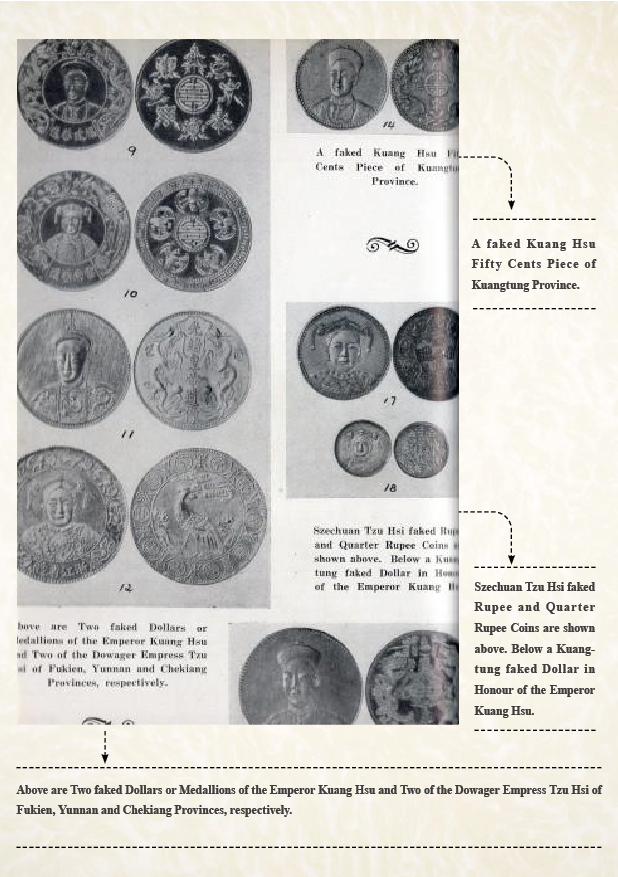 |
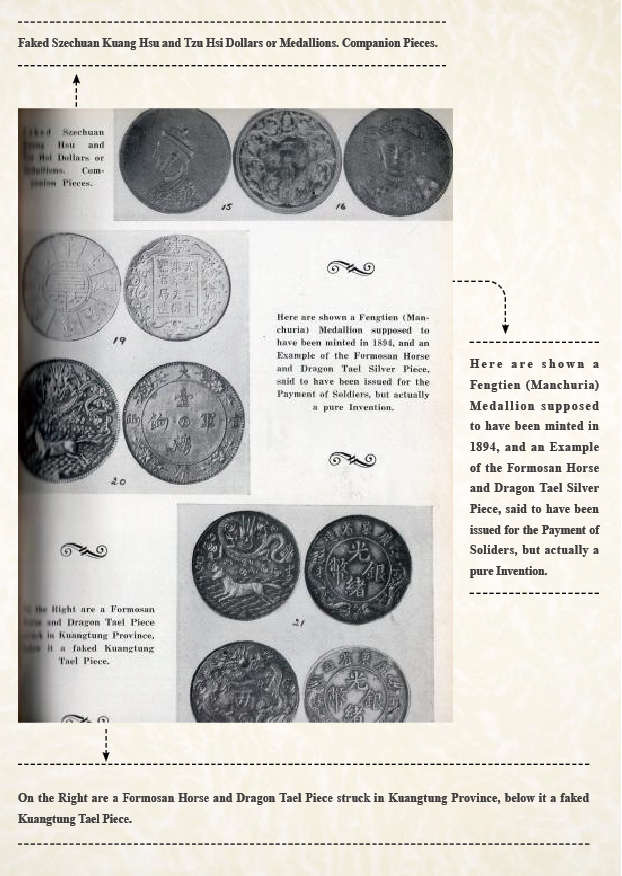 |
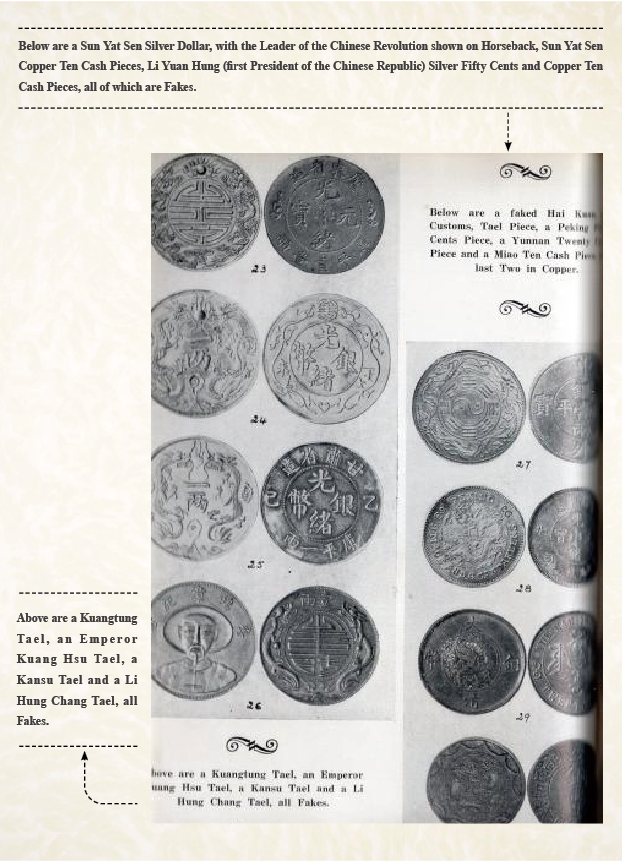 |
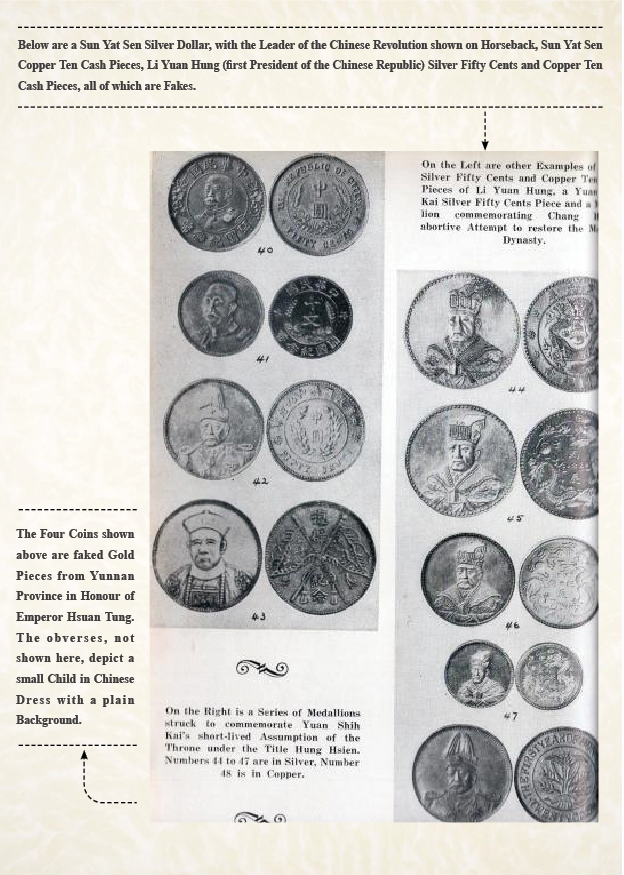 |
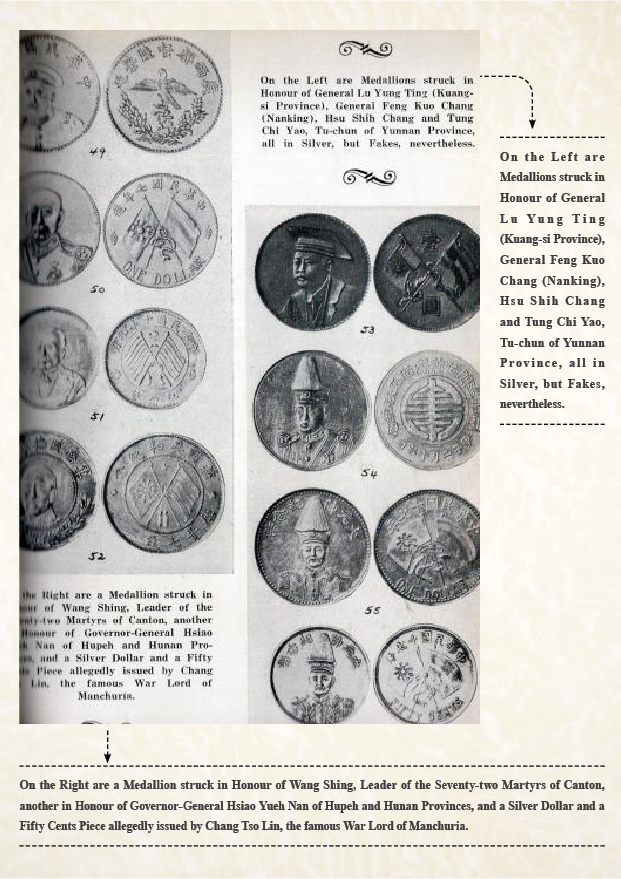 |
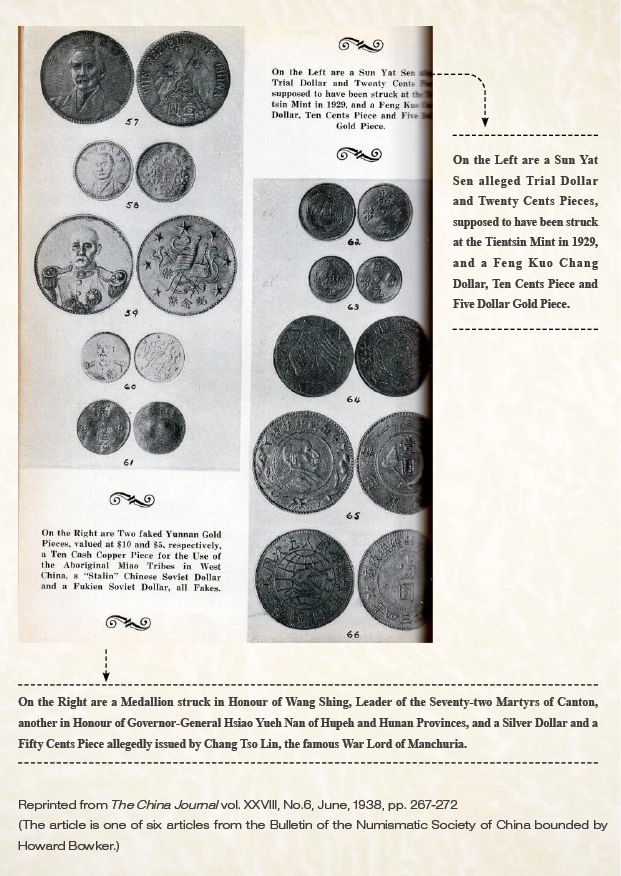 |
